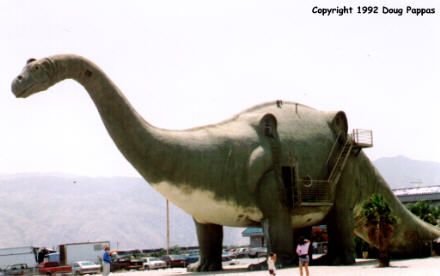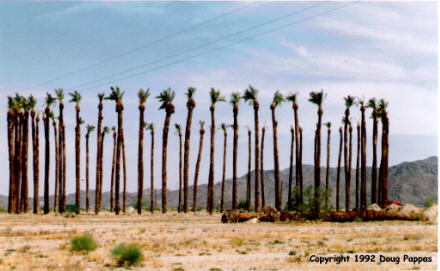 No, it's not the desert heat those were dinosaurs just north of the Interstate between San Bernardino and Palm Springs. The late Claude Bell spent 20 years building a larger-than-life concrete brontosaurus (oops, apatosaurus) and tyrannosaurus rex, dying shortly before the completion of T. rex. The belly of the brontosaurus contains a small museum/souvenir shop. About 10 years ago, the dinosaurs were discovered by Hollywood executives en route to their Palm Springs retreats. Feeling a strange affinity for larger-than-life creatures with tiny brains, the executives have cast the dinosaurs in numerous commercials and films. Then tried three times to find a place from which to phone for motel reservations before finding a phone that wasn't in use. In Desert Center ("next services 40 miles"), I stood, cursing and fuming, in front of the only two phones for fully 15 minutes before one of the cretins stopped reciting his life history.
No, it's not the desert heat those were dinosaurs just north of the Interstate between San Bernardino and Palm Springs. The late Claude Bell spent 20 years building a larger-than-life concrete brontosaurus (oops, apatosaurus) and tyrannosaurus rex, dying shortly before the completion of T. rex. The belly of the brontosaurus contains a small museum/souvenir shop. About 10 years ago, the dinosaurs were discovered by Hollywood executives en route to their Palm Springs retreats. Feeling a strange affinity for larger-than-life creatures with tiny brains, the executives have cast the dinosaurs in numerous commercials and films. Then tried three times to find a place from which to phone for motel reservations before finding a phone that wasn't in use. In Desert Center ("next services 40 miles"), I stood, cursing and fuming, in front of the only two phones for fully 15 minutes before one of the cretins stopped reciting his life history.
 The scenery improved once I crossed the sorry remnant of the Colorado River into Arizona. First stop: the "Hi Jolly" monument in Quartzsite, a town with 10 RV parking spots for every resident. The sculpted camel atop this pyramid-shaped grave is the final reminder of the U.S. Army's Great Camel Experiment. In 1856 and 1857, Secretary of War Jefferson Davis directed the Army to import 80 camels from the Middle East, hoping to train the desert beasts for service in the American Southwest. A number of Middle Eastern camel rivers accompanied their charges, among them a Syrian named Hadji Ali.
The camels lived up to their end of the deal but the Army didn't. Its horses and cattle stampeded in terror at the sight of the strange beasts, and American riders couldn't adapt to the camels' unusual gait. The Civil War soon ended the experiment. Most of the camel drivers returned home, while the camels and their descendants wandered the desert for decades, doubtless scaring more than one astonished cowboy into sobriety. Hadji Ali stayed in America and became a prospector. Locals who wouldn't or pronounce his name shortened it to Hi Jolly; after his death in 1902, the locals erected this picturesque monument.
A few miles east of Quartzsite US 60 regains its own identity, branching off the Interstate to become the scenic route to Phoenix. Even the overcast and sometime drizzle didn't bother me as I whizzed by old motels, gas stations, restaurants, farms, and just plain scenery in a way you can't do from an Interstate. Stopped for the night in Phoenix.
The scenery improved once I crossed the sorry remnant of the Colorado River into Arizona. First stop: the "Hi Jolly" monument in Quartzsite, a town with 10 RV parking spots for every resident. The sculpted camel atop this pyramid-shaped grave is the final reminder of the U.S. Army's Great Camel Experiment. In 1856 and 1857, Secretary of War Jefferson Davis directed the Army to import 80 camels from the Middle East, hoping to train the desert beasts for service in the American Southwest. A number of Middle Eastern camel rivers accompanied their charges, among them a Syrian named Hadji Ali.
The camels lived up to their end of the deal but the Army didn't. Its horses and cattle stampeded in terror at the sight of the strange beasts, and American riders couldn't adapt to the camels' unusual gait. The Civil War soon ended the experiment. Most of the camel drivers returned home, while the camels and their descendants wandered the desert for decades, doubtless scaring more than one astonished cowboy into sobriety. Hadji Ali stayed in America and became a prospector. Locals who wouldn't or pronounce his name shortened it to Hi Jolly; after his death in 1902, the locals erected this picturesque monument.
A few miles east of Quartzsite US 60 regains its own identity, branching off the Interstate to become the scenic route to Phoenix. Even the overcast and sometime drizzle didn't bother me as I whizzed by old motels, gas stations, restaurants, farms, and just plain scenery in a way you can't do from an Interstate. Stopped for the night in Phoenix.
Go to the next dayBack to Old Road Trips menuBack to ROADSIDEPHOTOS.COM home page